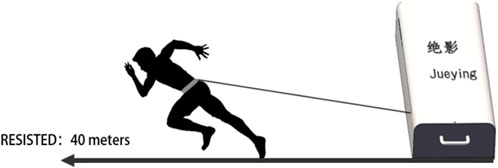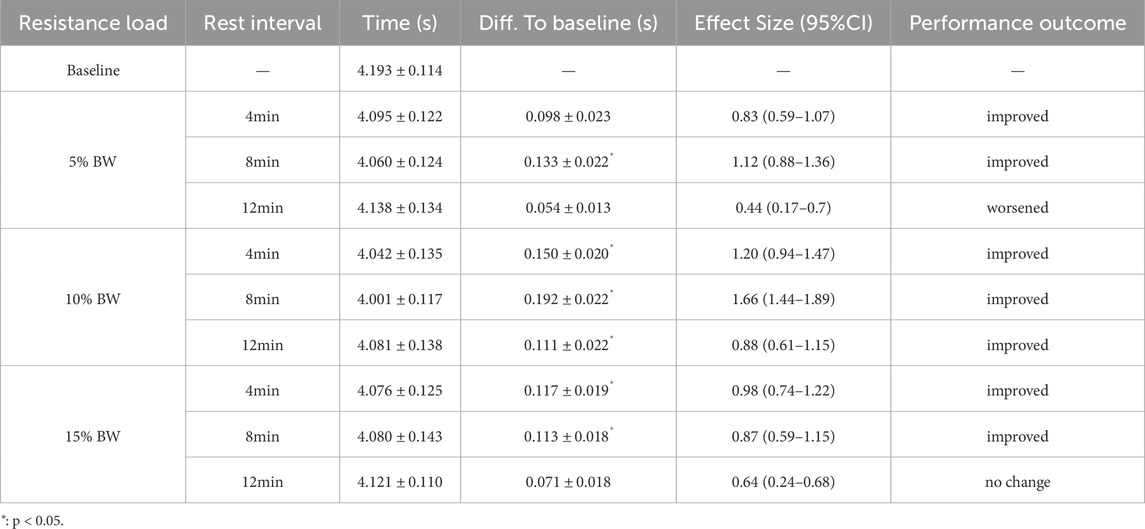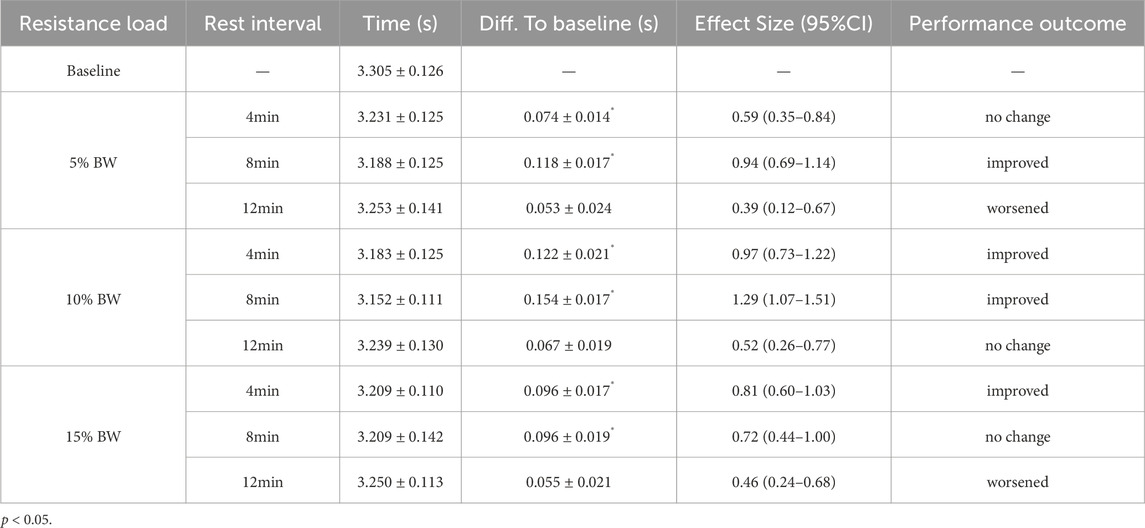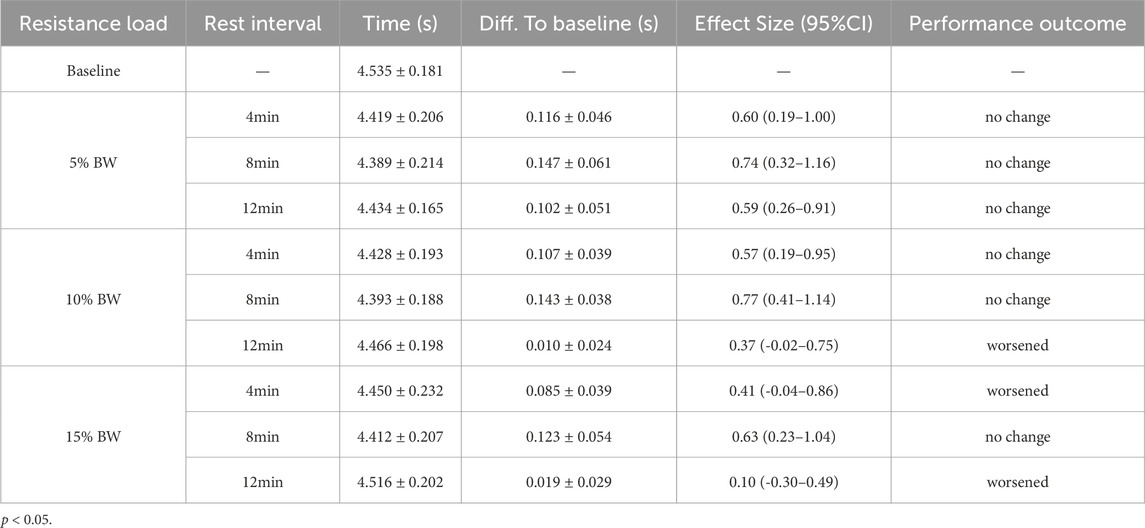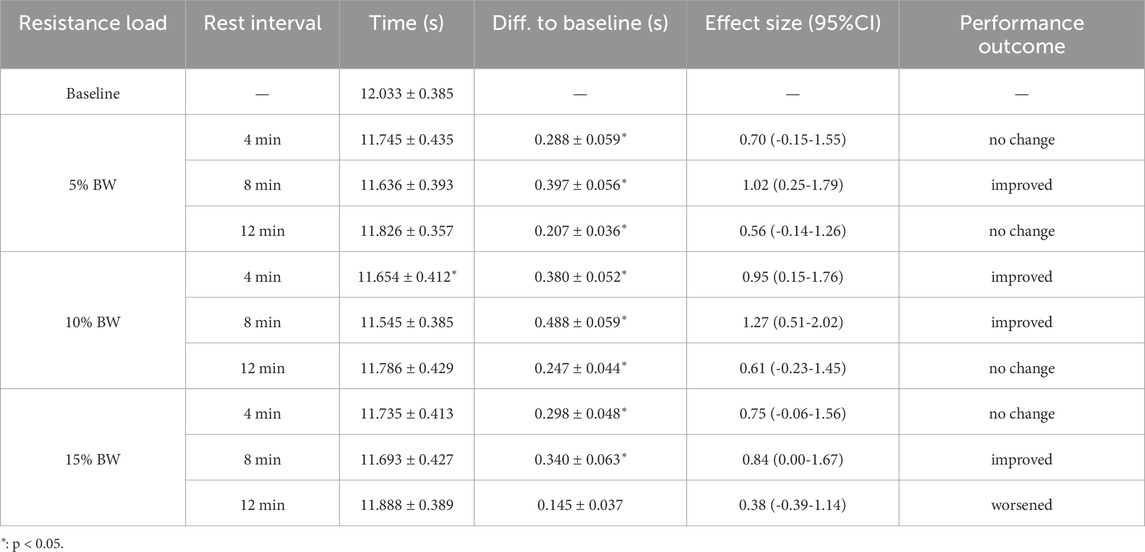- 1School of Sports Engineering, Beijing Sport University, Beijing, China
- 2China Athletics College, Beijing Sport University, Beijing, China
This study aimed to investigate the acute effects of resisted sprint-induced post-activation potentiation enhancement (PAPE) on 100-m sprint performance under three loading conditions (5%, 10%, and 15% body weight) and three rest intervals (4, 8, and 12 min), with a focus on segmental performance (0–30 m, 30–60 m, and 60–100 m). In a randomized crossover design, ten male college sprinters (age: 19.2
1 Introduction
In the highly anticipated Olympic Games, the 100-m sprint has become the focal point of track and field events, emphasizing athletes’ ability to achieve rapid acceleration and reach maximum speed over extremely short distances. The 100-m sprint comprises three primary phases: the acceleration phase, the maximum velocity phase, and the deceleration phase (Jones et al., 2009; Mero et al., 1992). Researchers have examined various sprint parameters, including split times, step length, step time, and ground contact time, within each phase (Chang et al., 2024; Colyer et al., 2018; Morin et al., 2012).
The acceleration after the start is a key technique in the 100-m dash. Importantly, the quality of this phase directly affects the maximum speed of the athlete (Harland and Steele, 1997; Slawinski et al., 2010). Top-level sprinters typically reach their maximum speed between 50 and 70 m. Therefore, the acceleration phase for these athletes can last longer and represent more than 30% of the total performance (Maćkała et al., 2015; Seidl et al., 2021). In contrast, non-elite athletes tend to reach their maximum speed earlier, resulting in a shorter acceleration phase (Haugen et al., 2019). Resisted sprint preactivation is a vital method to improve the ability of athletes to accelerate after the start by improving neuromuscular recruitment and increasing ground reaction forces during the start phase, allowing athletes to reach maximum or submaximum speeds from a stationary position in a shorter period of time (Faccioni, 1994; Clark et al., 2010). Resistance sprint exercises take the form of pulling a sled, tires or parachute, or using advanced equipment like the 1080Sprint™(1,080 Motion, Sweden) and DynaSpeed™(Ergotest Technology AS, Norway), which provide constant resistance during acceleration (Haugen et al., 2019; Matusiński et al., 2021a; Cross et al., 2018; Mangine et al., 2018).
Resisted sprint training yields significant effects in both long-term adaptations and acute changes. Long-term adaptations occur in trained athletes after several weeks of progressive training, leading to sustained improvements in performance. In contrast, acute changes refer to the immediate physiological responses following a single pre-activation session, where increased resistance enhances muscle activation and subsequently improves performance (Ross et al., 2001).
These acute changes are closely related to the concept of postactivation potentiation enhancement (PAPE). PAPE refers to the short-term increase in muscle force and power output following high-intensity exercise, such as resisted sprints (Prieske et al., 2020; Blaževich and Babault, 2019). Therefore, incorporating resisted sprints into a pre-activation regimen can be an effective strategy to harness the benefits of PAPE and achieve immediate performance enhancements. There has been considerable research on the effectiveness of resisted pre-activation to improve sprint performance, with loads ranging from 5% to 150% of body weight (BW) (Matusiński et al., 2021a; Mangine et al., 2018; Godwin et al., 2023; Winwood et al., 2016; Seitz et al., 2017; Van Den Tillaar and Von Heimburg, 2017; Alcaraz et al., 2008; Petrakos et al., 2016). However, selecting the optimal load for advanced training equipment to maximize the benefits of PAPE remains a challenge. Selecting optimal resistance loads requires an individualized strategy that integrates athlete-specific profiles with periodization goals. A wealth of research, including several notable studies, has investigated this challenge and concluded that a resisted sprint with 10% BW load can effectively induce a potentiating effect on subsequent sprint performance. Specifically, this load has been found to improve 20-m flying start sprint performance in elite female sprinters, demonstrating the potential for customized load selection to optimize PAPE outcomes (Matusiński et al., 2021a). Furthermore, external loads between 8% and 13% of BW appear to be optimal for simultaneously enhancing both power and sprint speed (Matusiński et al., 2021b). Furthermore, they concluded that resisted sprint pre-activation with a load of 10% BW improves sprinting speed over 50 m in elite male and female sprinters (Matusiński et al., 2022). However, it remains uncertain whether performance enhancement might also be observed over longer distances or during different phases of the sprint. Elite athletes exhibit extended acceleration phases during the start. Resisted sprints of 10–30 m may present limitations.
Research indicates that stronger individuals tend to exhibit more pronounced PAPE responses. This is due to their greater muscle mass and neuromuscular efficiency, allowing them to generate higher levels of force following a PAPE protocol. For instance, stronger athletes have shown significant improvements in performance metrics such as countermovement jump (CMJ) height and sprint times following high-intensity conditioning activities (Sa et al., 2020; Guo et al., 2022).
Given the established relationship between strength and PAPE, we hypothesized that athletes with superior 100-m sprint performance, who are likely to possess greater strength, would exhibit more notable improvements in the initial five steps of their sprint due to the PAPE effect. During the optimal rest period, when the PAPE is anticipated to be most effective, the performance in the initial five steps of a sprint was analyzed (Brink et al., 2022; Maroto-Izquierdo et al., 2020). By focusing on this optimal rest interval across all load conditions, we aimed to standardize the conditions and directly assess the impact of varying loads on sprint kinematics without the confounding influence of different recovery times. This approach allowed for a targeted investigation into how the potentiation effect, at its presumed peak, interacts with different levels of resistance to influence sprint performance.
2 Materials and methods
2.1 Participants
Ten male collegiate sprinters (age: 19.2
2.2 Experimental design
We employed a randomized, counterbalanced crossover design with three experimental factors: resistance loads (5%, 10%, and 15% of body mass), recovery intervals (4, 8, and 12 min), and sprint segments (0–30 m, 30–60 m, and 60–100 m). Each participant completed nine post-tests in total, corresponding to all combinations of load and rest conditions. To minimize order effects, the sequence of post-tests was randomized for each individual, with both the resistance load and recovery interval randomly assigned in each trial. The 19-day protocol was conducted at consistent times of day (
Resistance application was standardized using the motorized Jueying™ system (School of Sports Engineering, Beijing Sport University), which delivers velocity-dependent loads via a cable-driven mechanism (Hanran et al., 2024). Based on established dose-response relationships in post-activation performance enhancement (PAPE) (Matusiński et al., 2021a; Godwin et al., 2023; Brink et al., 2022), three relative loads were selected to systematically compare fatigue-potentiation dynamics. Recovery intervals were strategically chosen to capture the temporal transition from fatigue dominance (4 min) to PAPE predominance (8–12 min), consistent with established recovery kinetics (Boullosa et al., 2011; Chen et al., 2023; Kilduff et al., 2011).
2.3 Activation protocol
2.3.1 Equipment configuration
The motorized Jueying™ system was positioned 0.5 m behind the starting line, delivering velocity-dependent resistance through a cable-driven mechanism, as shown in Figure 1. Sprint times were recorded using the SmartSpeed™ timing system (VALD Performance, Australia), calibrated at 0, 30, 60, and 100 m positions following manufacturer specifications (Bond et al., 2017; Larson and Noonan, 2014).
2.3.2 Testing procedures
Session 1 (Baseline) consisted of anthropometric measurements followed by three maximal 100-m sprints, with the best performance retained for subsequent analysis. Sessions 2–10 (Intervention) comprised four sequential components (Jones et al., 2009): standardized warm-up protocol (20 min general preparation +10 min sprint-specific drills), (Mero et al., 1992),, 40-m resisted sprint under assigned load condition (Chang et al., 2024), passive recovery during the prescribed interval, and (Colyer et al., 2018) 100-m maximal sprint performance evaluation. To control for learning effects, condition order was randomized (Kang et al., 2008; Netz et al., 2019), with all sprints initiated from a standardized three-point stance 0.3 m behind the starting line (Mangine et al., 2018; Seitz et al., 2017).
2.4 Dependent variables
Primary outcomes included split times for three acceleration phases (0–30 m, 30–60 m, and 60–100 m) and total 100-m sprint time. These measures were selected based on their established sensitivity to resisted sprint training interventions (Bond et al., 2017; Cohen, 2013).
2.5 Statistical analysis
Statistical power was determined a priori using G*Power 3.1, indicating a minimum sample size of 7 participants for repeated-measures ANOVA with effect size = 0.4, power = 0.8, and
3 Results
The Shapiro-Wilk tests indicated that the sprint time data conformed to a normal distribution, permitting the use of parametric statistical analyses. Subsequent repeated-measures analyses were conducted to assess the impact of the intervention across various segments of the sprint. A linear trend analysis revealed no significant change in baseline sprint times across sessions (p
In the 0–30 m segment, the 10% load with an 8-min rest produced the greatest time reduction of 0.192 s compared to baseline (from 4.193
Throughout the 0–100 m sprint, condition 10% load with 8 min yielded a total time improvement of 0.488 s over baseline (from 12.033
These findings suggest that the PAPE effect is phase specific, mainly benefiting the acceleration (0–30 m) and early transition (30–60 m) phases, where neural and muscular responsiveness to preactivation is highest. The lack of significant enhancement in the 60–100-m segment reinforces the notion that PAPE exerts less influence during maximal velocity maintenance, which is more dependent on elastic energy return and technique.
In conclusion, the present study identifies the 10% body weight resistance with an 8-min rest interval as the most effective condition for eliciting acute performance gains through PAPE, with time reductions up to 4.6% in acceleration, 4.7% in transition, and 4.1% overall, thereby providing a robust, data-driven protocol for sprint performance optimization.
4 Discussion
The current investigation provides novel evidence that resisted sprint pre-activation using motorized resistance systems can acutely enhance sprint performance when implemented with precise load and recovery parameters. Our central finding–the 10% BW load combined with an 8-min recovery interval eliciting significant acceleration-phase improvements–advances understanding of post-activation performance enhancement (PAPE) in sprint contexts (Matusiński et al., 2021a; Li et al., 2024). These results align with emerging research on velocity-dependent resistance training while challenging conventional paradigms regarding optimal resisted sprint duration (Faccioni, 1994; Mangine et al., 2018).
The observed superiority of 10% BW over lighter (5% BW) and heavier (15% BW) loads corroborates the inverted-U relationship between mechanical stimulus and PAPE responsiveness (Godwin et al., 2023; Brink et al., 2022). This phenomenon likely reflects two competing mechanisms: insufficient neural recruitment at lower intensities versus excessive fatigue accumulation at higher loads (Boullosa et al., 2011). Notably, the 40-m resisted sprint distance in our protocol contrasts with traditional 20–30 m recommendations (Clark et al., 2010), suggesting modern motorized systems may extend effective PAPE stimulus ranges through precise resistance modulation (Hanran et al., 2024). Unlike sled resistance, which can vary due to surface friction and running technique, motorized resistance provides consistent and precisely controlled load across the sprint distance. This allows for finer modulation of resistance intensity and minimizes variability between trials, enhancing the reproducibility of training stimuli and PAPE responses. This technological advancement enables athletes to accumulate greater impulse while maintaining movement velocity profiles–a critical factor absent in sled-based methodologies (Sa et al., 2020).
Phase-specific performance patterns revealed fundamental biomechanical insights. The 0–30m and 30–60 m improvements (1.8% and 1.2% respectively) versus negligible 60–100 m changes (−0.3%) underscore PAPE’s preferential impact on acceleration mechanics (Prieske et al., 2018). This dichotomy aligns with electromyographic evidence demonstrating enhanced activation of key agonist muscles—including the psoas major, gluteus maximus, hamstrings, gluteus medius, and ankle plantarflexors—during the initial acceleration phase, with markedly reduced activation observed at maximal velocity (Li et al., 2024). From an energy systems perspective, the phosphocreatine resynthesis window (4–8 min) may synergize with PAPE’s neural mechanisms during early sprint phases (Chen et al., 2023), whereas late-phase velocity maintenance relies more on elastic energy utilization–a system less influenced by acute resistance priming (Kilduff et al., 2011).
Methodological considerations warrant particular emphasis. The discrepancy between initial pairwise comparisons and conservative post hoc results highlights the importance of statistical rigor in multi-factorial PAPE studies (Cohen, 2013). While traditional resisted sprint research often employs uncorrected comparisons (Faccioni, 1994), our Bonferroni-adjusted approach revealed that only the 10% BW condition maintained significance–a finding with critical implications for coaching practice (Netz et al., 2019). This statistical conservatism proves essential when balancing type I error risks against the practical need for actionable training prescriptions.
Several limitations contextualize these findings. The absence of synchronized kinetic data restricts mechanistic interpretation of force-velocity adaptations. Furthermore, the lack of neuromuscular data (e.g., EMG), force–velocity profiling, and kinematic analyses, which limits our understanding of the underlying mechanisms. Furthermore, we clarify that the sample consisted exclusively of male athletes, so the findings cannot be directly generalized to female populations.
5 Conclusion
This study shows that a 10% BW load with an 8-min rest interval effectively enhances sprint performance, particularly in the 0–30 and 30–60 m segments. While resisted sprint pre-activation significantly improves acceleration, its impact on maintaining speed in the 60–100 m segment is limited.
Data availability statement
The datasets presented in this study can be found in online repositories. The names of the repository/repositories and accession number(s) can be found in the article/Supplementary Material.
Ethics statement
The studies involving humans were approved by Sports Science Experiment Ethics Committee of Beijing Sport University. The studies were conducted in accordance with the local legislation and institutional requirements. Written informed consent for participation in this study was provided by the participants’ legal guardians/next of kin.
Author contributions
WC: Data curation, Visualization, Writing – original draft. DQ: Formal Analysis, Project administration, Writing – review and editing. HZ: Conceptualization, Methodology, Validation, Writing – review and editing. YS: Supervision, Writing – review and editing.
Funding
The author(s) declare that financial support was received for the research and/or publication of this article. The study is supported by the Fundamental Research Funds for Central Universities (Grant Number: 2021TD010). The funders had no role in study design, data collection and analysis, decision to publish, or preparation of the manuscript.
Acknowledgments
We would like to express our sincere gratitude to all the authors who contributed to this study, as well as to the participants who generously gave their time and effort. Their involvement was crucial to the success of our research. We also acknowledge the support from institutions and colleagues who provided valuable insights and assistance during the study. Thank you all for your commitment and contributions.
Conflict of interest
The authors declare that the research was conducted in the absence of any commercial or financial relationships that could be construed as a potential conflict of interest.
Generative AI statement
The author(s) declare that Generative AI was used in the creation of this manuscript. Generative AI was employed to refine the language used throughout the manuscript. This included correcting grammatical errors, improving sentence structure, and ensuring consistency in tone and style.
Publisher’s note
All claims expressed in this article are solely those of the authors and do not necessarily represent those of their affiliated organizations, or those of the publisher, the editors and the reviewers. Any product that may be evaluated in this article, or claim that may be made by its manufacturer, is not guaranteed or endorsed by the publisher.
Supplementary material
The Supplementary Material for this article can be found online at: https://www.frontiersin.org/articles/10.3389/fphys.2025.1544291/full#supplementary-material
References
Alcaraz P. E., Palao J. M., Elvira J. L., Linthorne N. P. (2008). Effects of three types of resisted sprint training devices on the kinematics of sprinting at maximum velocity. J. Strength Cond. Res. 22 (3), 890–897. doi:10.1519/JSC.0b013e31816611ea
Blaževich A. J., Babault NJFIP (2019). Post-activation potentiation versus post-activation performance enhancement in humans: historical perspective, underlying mechanisms, and current issues. Front. Physiol. 10, 1359. doi:10.3389/fphys.2019.01359
Bond C. W., Willaert E. M., Noonan B. C. (2017). Comparison of three timing systems: reliability and best practice recommendations in timing short-duration sprints. J. Strength Cond. Res. 31 (4), 1062–1071. doi:10.1519/JSC.0000000000001566
Boullosa D. A., Tuimil J. L., Alegre L. M., Iglesias E., Lusquiños F. (2011). Concurrent fatigue and potentiation in endurance athletes. Int. J. Sports Physiol. Perform. 6 (1), 82–93. doi:10.1123/ijspp.6.1.82
Brink N. J., Constantinou D., Torres G. (2022). Postactivation performance enhancement (PAPE) of sprint acceleration performance. Eur. J. Sport Sci. 22 (9), 1411–1417. doi:10.1080/17461391.2021.1955012
Chang F., Qian D., Zong S., Shen Y. (2024). The effect of different resistance and assistance loads on 30-m sprint kinematics. PLoS ONE 19 (3), e0298517. doi:10.1371/journal.pone.0298517
Chen Y., Su Q., Yang J., Li G., Zhang S., Lv Y., et al. (2023). Effects of rest interval and training intensity on jumping performance: a systematic review and meta-analysis investigating post-activation performance enhancement. Front. Physiol. 14, 1202789. doi:10.3389/fphys.2023.1202789
Clark K. P., Stearne D. J., Walts C. T., Miller A. D. (2010). The longitudinal effects of resisted sprint training using weighted sleds vs. weighted vests. J. Strength Cond. Res. 24 (12), 3287–3295. doi:10.1519/JSC.0b013e3181b62c0a
Cohen J. (2013). Statistical power analysis for the behavioral sciences. Abingdon, United Kingdom: Routledge.
Colyer S. L., Nagahara R., Salo A. I. (2018). Kinetic demands of sprinting shift across the acceleration phase: novel analysis of entire force waveforms. Scand. J. Med. Sci. Sports 28 (7), 1784–1792. doi:10.1111/sms.13093
Cross M. R., Lahti J., Brown S. R., Chedati M., Jimenez-Reyes P., Samozino P., et al. (2018). Training at maximal power in resisted sprinting: optimal load determination methodology and pilot results in team sport athletes. PLoS ONE 13 (4), e0195477. doi:10.1371/journal.pone.0195477
Faccioni A. J. M. (1994). Assisted and resisted methods for speed development: part 2. Mod. Athlete Coach 32 (3), 8–12.
Godwin M., Dhone S., Newman MJIOS (2023). Post-activation performance enhancement (PAPE) after resisted sprinting in recreationally active participants: a double-blind randomised crossover trial. Int. J. Strength Cond. 3 (1). doi:10.47206/ijsc.v3i1.226
Guo W., Liang M., Lin J., Zhou R., Zhao N., Aidar F. J., et al. (2022). Time duration of post-activation performance enhancement (PAPE) in elite Male sprinters with different strength levels. Children 10 (1), 53. doi:10.3390/children10010053
Hanran Q., Dexing Q., Shousheng X., Shen Y. f. (2024). Validity and test-retest reliability of a resistance training device for smith machine back squat exercise. iScience 27 (1), 108582. doi:10.1016/j.isci.2023.108582
Harland M., Steele J. R. (1997). Biomechanics of the sprint start. Sports Med. 23, 11–20. doi:10.2165/00007256-199723010-00002
Haugen T., Seiler S., Sandbakk Ø., Tønnessen E. (2019). The training and development of elite sprint performance: an integration of scientific and best practice literature. Sports Med. Open 5 (1), 44. doi:10.1186/s40798-019-0221-0
Jones R., Bezodis I., Thompson A. (2009). Coaching sprinting: expert coaches’ perception of race phases and technical constructs. Int. J. Sports Sci. Coach. 4 (3), 385–396. doi:10.1260/174795409789623964
Kang M., Ragan B. G., Park J.-H. (2008). Issues in outcomes research: an overview of randomization techniques for clinical trials. J. Athl. Train. 43 (2), 215–221. doi:10.4085/1062-6050-43.2.215
Kilduff L. P., Cunningham D. J., Owen N. J., West D. J., Bracken R. M., Cook C. J. (2011). Effect of postactivation potentiation on swimming starts in international sprint swimmers. J. Strength Cond. Res. 25 (9), 2418–2423. doi:10.1519/JSC.0b013e318201bf7a
Larson D. P., Noonan B. C. (2014). A simple video-based timing system for on-ice team testing in ice hockey: a technical report. J. Strength Cond. Res. 28 (9), 2697–2703. doi:10.1519/JSC.0000000000000570
Li L., Mo L., Liu Y., Mei T. (2024). The impact of different velocity losses on post-activation performance enhancement (PAPE) effects in sprint athletes: a pilot randomized controlled study. Sports 12 (6), 157. doi:10.3390/sports12060157
Maćkała K., Fostiak M., Kowalski K. (2015). Selected determinants of acceleration in the 100m sprint. J. Hum. Kinet. 45 (1), 135–148. doi:10.1515/hukin-2015-0014
Mangine G. T., Huet K., Williamson C. A., Bechke E., Serafini P., Bender D., et al. (2018). A resisted sprint improves rate of force development during a 20-m sprint in athletes. J. Strength Cond. Res. 32 (6), 1531–1537. doi:10.1519/JSC.0000000000002030
Maroto-Izquierdo S., Bautista I. J., Martín Rivera F. (2020). Post-activation performance enhancement (PAPE) after a single bout of high-intensity flywheel resistance training. Biol. Sport 37 (4), 343–350. doi:10.5114/biolsport.2020.96318
Matusiński A., Gołaś A., Zajaç A. (2021b). Optimizing the load for peak power and peak velocity development during resisted sprinting. Phys. Act. Rev. 1 (9), 128–134.
Matusiński A., Gołas A., Zajac A., Maszczyk A. (2022). Acute effects of resisted and assisted locomotor activation on sprint performance. Biol. Sport 39 (4), 1049–1054. doi:10.5114/biolsport.2022.108706
Matusiński A., Pietrzak P., Krzysztofik M., Gołaś A. (2021a). The effects of resisted post-activation sprint performance enhancement in elite female sprinters. Front. Physiol. 12, 651659. doi:10.3389/fphys.2021.651659
Mero A., Komi P., Gregor R. J. (1992). Biomechanics of sprint running: a review. Sports Med. 13, 376–392. doi:10.2165/00007256-199213060-00002
Morin J. B., Bourdin M., Edouard P., Peyrot N., Samozino P., Lacour J. R. (2012). Mechanical determinants of 100-m sprint running performance. Eur. J. Appl. Physiol. 112, 3921–3930. doi:10.1007/s00421-012-2379-8
Netz Y., Lidor R., Ziv G. (2019). Small samples and increased variability–discussing the need for restricted types of randomization in exercise interventions in old age. Eur. Rev. Aging Phys. Act. 16, 17–18. doi:10.1186/s11556-019-0224-3
Petrakos G., Morin J.-B., Egan B. J. S. (2016). Resisted sled sprint training to improve sprint performance: a systematic review. Sports Med. 46, 381–400. doi:10.1007/s40279-015-0422-8
Prieske O., Behrens M., Chaabene H., Granacher U., Maffiuletti N. A. (2020). Time to differentiate postactivation “potentiation” from “performance enhancement” in the strength and conditioning community. Sports Med. 50 (9), 1559–1565. doi:10.1007/s40279-020-01300-0
Prieske O., Krüger T., Aehle M., Bauer E., Granacher U. (2018). Effects of resisted sprint training and traditional power training on sprint, jump, and balance performance in healthy young adults: a randomized controlled trial. Front. Physiol. 9, 156. doi:10.3389/fphys.2018.00156
Ross A., Leveritt M., Riek S. (2001). Neural influences on sprint running: training adaptations and acute responses. Sports Med. 31 (6), 409–425. doi:10.2165/00007256-200131060-00002
Sa udo B., De Hoyo M., Haff G. G., Muñoz-López A. (2020). Influence of strength level on the acute post-activation performance enhancement following flywheel and free weight resistance training. Sensors 20 (24), 7156. doi:10.3390/s20247156
Seidl T., Russomanno T. G., Stöckl M., Lames M. (2021). Assessment of sprint parameters in top speed interval in 100 m sprint—A pilot study under field conditions. Front. Sports Act. Living 3, 689341. doi:10.3389/fspor.2021.689341
Seitz L. B., Mina M. A., Haff G. G. (2017). A sled push stimulus potentiates subsequent 20-m sprint performance. J. Sci. Med. Sport 20 (8), 781–785. doi:10.1016/j.jsams.2016.12.074
Slawinski J., Bonnefoy A., Leveque J. M., Ontanon G., Riquet A., Dumas R., et al. (2010). Kinematic and kinetic comparisons of elite and well-trained sprinters during sprint start. J. Strength Cond. Res. 24 (4), 896–905. doi:10.1519/jsc.0b013e3181ad3448
Van Den Tillaar R., Von Heimburg EJHM (2017). Comparison of different sprint training sessions with assisted and resisted running: effects on performance and kinematics in 20-m sprints. Hum. Mov. 18 (2), 21–29. doi:10.1515/humo-2017-0013
Keywords: post-activation potentiation enhancement, sprint, load, rest interval, resisted sprint training
Citation: Chen W, Qian D, Zhang H and Shen Y (2025) Post-activation performance enhancement in resisted sprinting: effects of different loads and rest intervals on 100-m sprint segments. Front. Physiol. 16:1544291. doi: 10.3389/fphys.2025.1544291
Received: 20 January 2025; Accepted: 24 July 2025;
Published: 12 August 2025.
Edited by:
Giuseppe D'Antona, University of Pavia, ItalyReviewed by:
Abdul Rashid Aziz, Singapore Sports Institute (SSI), SingaporeJamie Ghigiarelli, Hofstra University, United States
Copyright © 2025 Chen, Qian, Zhang and Shen. This is an open-access article distributed under the terms of the Creative Commons Attribution License (CC BY). The use, distribution or reproduction in other forums is permitted, provided the original author(s) and the copyright owner(s) are credited and that the original publication in this journal is cited, in accordance with accepted academic practice. No use, distribution or reproduction is permitted which does not comply with these terms.
*Correspondence: Dexing Qian, cWlhbmRleGluZ0Bic3UuZWR1LmNu
 Weixiong Chen
Weixiong Chen Dexing Qian
Dexing Qian Huaichuan Zhang2
Huaichuan Zhang2